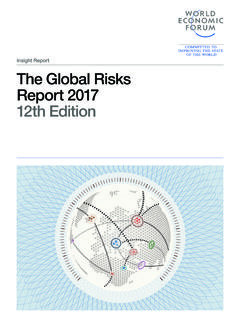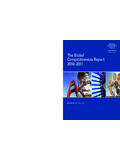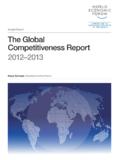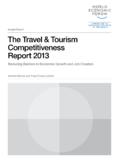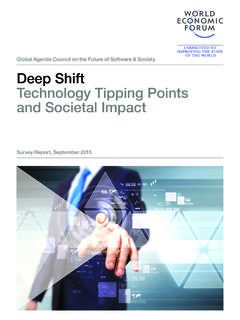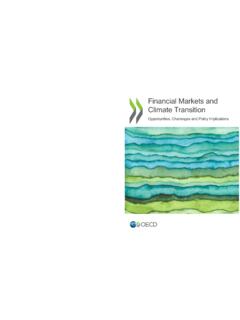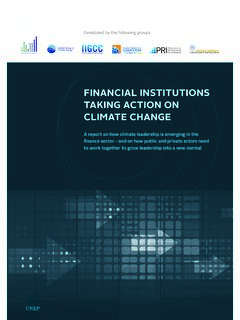Transcription of Impact of COVID-19 on the Global Financial System
1 Platform for Shaping the Future of Financial and Monetary Systems Impact of COVID-19 . on the Global Financial System Recommendations for Policy-Makers Based on Industry Practitioner Perspectives April 2020. Impact of COVID- 19 on the global financial system Background This briefing is the outcome of several multistakeholder dialogues organized by the World Economic Forum's Platform for Shaping the Future of Financial and Monetary Systems. Since mid-March, the Forum has virtually convened senior leaders from Financial institutions , international organizations, central banks and other institutions for several discussions about the Impact of COVID-19 on the Financial System . These discussions aimed to identify emerging Financial stability risks, understand adjustments to consumption and investment due to COVID-19 , discuss where policy-maker attention is required, and share emergency measures implemented by firms as well as lessons learned from this crisis and earlier times of market stress.
2 This briefing summarizes the key findings of these discussions, providing insight into Financial market trends, private-sector views of government responses to date and priorities for future policy, areas of risk and uncertainty, and expectations for the future. While some context on market activity and policy decisions is provided, the focus is on sharing the views expressed by the participants in these Forum-hosted discussions, rather than a comprehensive overview of the situation. The goal is to present the current state of debate among key Financial System stakeholders. As the human and economic impacts of COVID-19 continue to be felt, the Forum will convene similar discussions and share this learning. 2. Impact of COVID- 19 on the global financial system Summary of policy recommendations 1. Flattening the curve of firm mortality must be a top policy priority, and governments will have to expand the size and scope of support programmes over time.
3 2. Governments, including regulators and central banks, must continue to coordinate policy on a Global level to help maintain Financial stability. Within countries, policy guidance must be clear and consistent across regulatory agencies. 3. Policy-makers must ensure that the Financial System remains capable of safely meeting the public's need for Financial services through digital channels. 4. Advanced economies may need to further expand the support offered to emerging markets and developing economies. 3. Impact of COVID- 19 on the global financial system Key insights 1. The Global Financial System has markets from propagating into market -wide emerged from an initial period of extreme disruptions. At the same time, central banks stress, in large part due to governments' announced plans to expand asset purchase efforts to stimulate the economy, central programmes, with the goal of reintroducing banks' speed at addressing market liquidity into key asset classes, surprising disruptions, and the resilience of Financial some participants, who said they expected institutions .
4 A more moderate central bank response. At the end of February 2020, Financial In late March, equity markets began to markets entered a risk-off phase with rebound following announcements of significantly increased volatility across substantial fiscal support packages by markets. Equity markets began declining large advanced economies. According to rapidly, losing around 30% of market value in market participants, this rebound reflects a matter of weeks, with the speed of the sell- expectations that the size and targeting of off exceeding that of the Global Financial crisis the fiscal packages averaging 10% of GDP. of 2008-2009 (GFC). across the United States and Europe, with a focus on supporting small businesses and By early March, short-term funding markets hard-hit industries will effectively address the and international US dollar funding markets macroeconomic slowdown.
5 Started to show signs of stress and, in the weeks to follow, there were signs of illiquidity Moreover, throughout this period, equity in the US Treasury market , the deepest and market infrastructure remained remarkably most liquid Financial market in the world. resilient, which, according to some These stresses carried through into credit participants, enabled markets to remain markets, making it difficult for firms and fully functional and begin to rebound. governments to borrow funds at any tenure. Exchanges utilized tools like market -wide circuit breakers, stock-specific guardrails Central banks reacted quickly to the and dynamic restrictions on short selling emerging signs of stress, applying lessons to maintain both orderly functioning and learned during the GFC. Participants market liquidity. Participants also noted from across the Financial System noted that post-trade infrastructures remained that the US Federal Reserve and other fully operational at record high volumes and central banks began addressing funding volatility, in addition to effectively managing market impairment in a matter of days, as margin requirements to prevent potential opposed to the months it took in some settlement failures from spilling over.
6 Cases during the GFC. In doing so, they prevented stresses in underlying funding 4. Impact of COVID- 19 on the global financial system In credit markets, the story has been 2. While the initial acute phase of the somewhat mixed to date, but participants Financial crisis may have eased, firms and have been generally encouraged by the policy-makers remain concerned about a direction of developments. Whereas primary range of risks that could present a threat bond markets had effectively closed in early to Financial stability and, ultimately, the March, by early April investment banks economic recovery. reported strong demand for new credit issuance by investment-grade borrowers. All stakeholders have repeatedly highlighted Participants attributed the re-opening of the degree of uncertainty currently plaguing primary credit markets to central bank Financial markets and institutions .
7 There action as well as a somewhat improved is uncertainty about how badly the virus macroeconomic outlook. On the other hand, will affect different countries, how long high-yield markets and secondary bond containment measures must persist in markets remained largely closed, although different markets, how effective policy there is some optimism that new central will be at mitigating lost activity, and how bank corporate credit facilities could provide households and firms will change their a backstop in these markets. behaviour in the medium term. Participants from the private sector and While Financial System resilience, fiscal support, policy-makers agree that a key difference regulatory flexibility and liquidity provision to between the GFC and this crisis has been date have helped ensure that the Financial the role of banks.
8 Unlike the GFC, this crisis System is supportive of economic recovery, is fundamentally a public health emergency a more protracted slowdown may present that has become an economic downturn as new risks to the Financial System . Thus, governments have taken measures to stop while the initial phase of the crisis has eased, the spread of the disease. But, rather than participants are keenly aware that there may contributing to the problem, banks are now a be greater turmoil affecting the Financial System major part of the solution, due in large part to as the economic fallout continues, potentially the strength of their balance sheets. precipitating a Financial crisis down the line. The post-crisis regulatory framework has While equity markets have rebounded led to substantial increases in capital held somewhat since their March lows, these by large advanced economy banks, in rebounds may be premature, with market addition to more liquid assets and more valuations not reflecting potential extreme stable sources of funding.
9 Not only are banks downside scenarios. Participants noted relatively stable, but they are also serving that volatility in equity prices likely reflects as the primary transmission mechanism for oscillation between more optimistic and much of the business support components of pessimistic macroeconomic outlooks among many countries' fiscal packages. Participants investors. However, some participants argued advocate that the focus of regulatory and that, even when equity markets reached their central bank policy should be on maintaining lowest levels in March, market valuations of this stability while enabling banks to meet the firms may not have priced in the most severe, needs of the real economy, which may be a yet plausible, downside scenarios. difficult balance to achieve. 5. Impact of COVID- 19 on the global financial system One view of such a scenario would involve high-yield credit markets middle- market a severe protracted recession in advanced firms' traditional source of capital and liquidity economies leading to a credit crunch as are largely closed due to crisis-driven risk banks face greater credit losses than their aversion.
10 Given the scale of high-yield and balance sheets can withstand, despite leveraged loan markets globally, participants ongoing central bank support which, in fear that failure to support these firms could turn, would deepen the recession. While lead to large balance sheet losses for both this scenario is not seen as likely, some banks and investors, in addition to additional participants said they believe that equity blows to employment and income. market investors should be more cognizant of downside risks. 3. The economic and Financial crisis in emerging market and developing While investment grade borrowers have economies may be more severe than in begun issuing new bonds, secondary advanced economies. markets have remained largely closed. Asset managers have reported that it is difficult to Both private-sector participants and policy- find any price signals in the markets.
